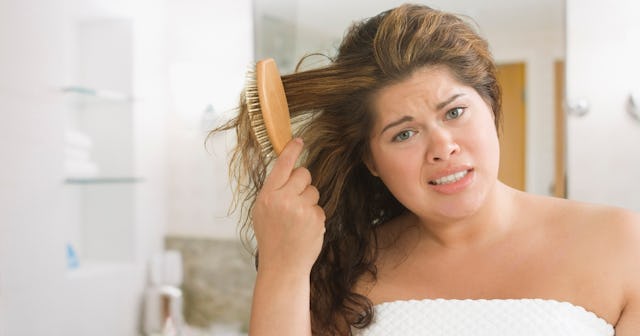Not Today, Knots! Here's How To Detangle Hair Without A Lot Of Stress And Breakage

Recently, I treated myself to a haircut. The freedom of a shorter ‘do was nice for the summer months, but it was also a healthy choice. Not only had my long hair become prone to breakage, but the hair knots were starting to get out of control. When you have a preference for long hair, knots can often happen. Not quite the beauty routine I had in mind. But, mats are also very common in thicker manes. My hair is also wavy — which means a night when the bedroom is too warm will lead to a morning hairdo that’s a bit knotty and out of control.
Figuring out how to detangle a kid’s hair is also important to know when you’re in the midst of a hectic morning routine. When you brush the hair of others, hair knots may not seem apparent until they’re caught in the brush. Many kids fear having someone touch their head if it’s prone to knotting. You can’t deny it — pulls at the scalp hurt. It’s serious — hair knots can even cause hair hygiene phobia. But if the hair isn’t brushed properly, the problem will just manage to get worse.
If your stomachs all up in knots over knots, take a breather. There’s always a solution. Here’s how to detangle hair and rid of those hair knots in a healthy way that won’t cause quite as much distress.
RELATED: The Best Detangling Hair Brushes For Kids—So There’ll Be Less Screaming And More Brushing
What causes hair knots?
First things first, what causes hair knots, anyway? A knot begins as simply two interwoven strands of hair, but when the strand’s outer layer, the cuticle, is damaged or textured, the chances of the knot growing and attracting more strands increase. Dry, heat, color, and product damaged hair is more prone to knots. The same is true for curly, natural, and long hair.
How to Detangle Hair
Brushing it Out
Before all else, finding a good brush that works well on hair knots will be key. You’ll want to find a paddle brush that will gently help your hair recover from the knots. It also may be better to start brushing from the bottom. Taking small segments at a time will help. By gently focusing on the knot itself — and not the rest of your hair — your problem will be quickly solved.
Tangles and knots may be more common in very curly hair and natural hair. If you have a lot of hair, it makes sense to start the process in the shower. Usually, hair is more manageable when it’s wet and has lots of conditioning products in it. To detangle natural hair when dry, it’s best to take your time and work hair into sections. Hair can be separated using clips.
Condition, Condition, Condition
A good conditioning spray is a great way to battle hair knots. When figuring out how to detangle hair, you might have run across a few products that promise results. They can be a huge help, but it’s important to find the right one for you. Detangling sprays may be better than lotions for some hair textures, so you’ll definitely want to do some research. In general, thinner hair will react best to a light spray of mist, while more coarse hair will often need all the moisture and protection it can get from a detangling cream or leave-in conditioner. All hair is different, so not all hair products will give everyone similar results.
You can also make your own detangling spray at home if you want to go the more natural and organic route. Apple cider vinegar and water alone can make for a great spray detangler. Not like it’s surprising, as apple cider vinegar can do almost anything.
Run Fingers Through the Hair
When it comes to damaged, knotty hair, sometimes the first place to start is literally at the tip of your fingers. Try to comb out hair using your fingers to mimic a wide-toothed comb, and use an in-shower conditioner to your advantage. Don’t be too harsh — treat your hair lovingly and gently to help avoid further damage.
Post-shower hair care is also important when trying to battle hair knots. When you get out of the shower, try not to rub your hair with your bath towel. It may seem like an easy way to dry, but it’s doing more damage than you might think. If you must dry your soaking hair, try a T-shirt, it’s much gentler on the follicles. You can also find a drying towel that’s meant just for your hair. If it happens to be made of bamboo or microfiber, even better — those will be much gentler on your locks.
How to Get Really Bad Knots Out of Hair
Knots in your hair are the worse! So, to minimize breakage and time spent detangling hair, here are a few tips to keep your hair knot-free.
- Braid your hair before bed. This will keep it in one place and from knotting up. It’s especially helpful to braid it while it’s wet or before a workout.
- Cotton pillowcases are soft, but they aren’t good for your hair follicles. Using a satin pillowcase will make your hair less messy as you toss your head around at night.
- Get your hair trimmed. Getting rid of split ends and damaged hair will help your hair become less tangled.
- Before going to bed, put your hair in a super high ponytail. This will help keep your hair in one place.
- Don’t always comb your hair in a downward motion. Switch it up and avoid pulling from the nape of the neck. This helps you reach all the knots, including the hidden ones.
- Before shampooing your hair, brush it out to prevent knots from forming.
This article was originally published on